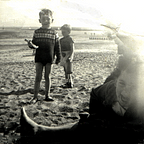The Fall of Haydon: Part 2
Neglected genius? Or ‘terrible painter’ brought down by ‘mad vanity’?
Weeks after the closure of his Eygptian Hall exhibition came another crushing blow. Haydon had long campaigned for the commissioning of public art for major buildings . He was influential in setting up a Royal Commission in 1842.
The Commission, which included a former student of Haydon, now announced there would be mural in the newly rebuilt House of Lords. The chosen artist would be decided by a cartoon competition
Haydon entered two cartoons The Curse on Adam and Eve and Edwards the Black Prince Entering London . According to Elizabeth Barrett, the announcement that neither was selected ‘was a thunderbolt to him’.
EB learned this through a letter which resumed her long dormant correspondence with the artist, twenty years her senior. This letter also included odd request.
Benjamin Haydon and Elizabeth Barret a short walk from each other but never met — with EB stonewalling every request for a chaperoned visit. She much preferred pen pals to face-to-face encounters.
At one point, Haydon had half-jokingly threatened to come and shout through the letter box of 50 Wimpole Street. He never did but this new request was slightly unsettling. Could Miss Barrett possibly take custody of some paintings and journals for a time? Puzzled, EB agreed.
Three trunks and five pictures duly were delivered to Wimpole Street on Thursday 18th June. On the same day, Haydon’s landlord informed him that the family would be evicted for non payment of rent. Other debtors were closing in and prison beckoned.
The summer of 1846 was the hottest London had ever experienced. Over the weekend Haydon furiously in the intense heat of his studio, determined to complete his final works. At night his family heard him pacing manically, his mind whirring with a plan to ensure them a brighter future.
Early on the morning of Monday June 22nd Heydon walked to Oxford Street, where he bought a pistol from a gunmaker called Riviere. Returning to his house, he breakfasted alone. He then went back to his studio locking the door behind him. There he completed his nineteen clause will, his final journal and letters to each of this daughters and the Prime Minister.
At ten o’clock Mrs Heydon climbed the stairs to her dressing room. As she passed the studio she tried the locked door. He calls out abruptly.
‘It’s only me,’ she replied. ‘I am just going up to dress before going to Brixton.’
‘Oh very well,’ he said from behind the locked door. As she turned away Heydon called out, ‘God bless you. I will see you presently.’
It was later in the day that Mary Heydon entered the studio. Her father was lying in front of his final canvas surrounded by what she assumed to be red paint. Then she saw the pistol and the razor that had finished the task.
In his will Haydon made a direct appeal to the Prime Minister for a pension to take care of his dependents. Sir Robert Peel immediately agreed and his genuine sorrow was widely applauded in the press.
The inquest was followed avidly by literary London. Most agreed with its conclusion that Haydon’s financial problems had lead to a temporary loss of his sanity, though there were those who saw a ‘mad vanity’ in his his final actions
As is customary, critics were also generous about the quality of his work. One dissenting voice was Dickens:
“All his life [Haydon] had utterly mistaken his vocation. No amount of sympathy with him and sorrow for him — ought to prevent one from saying that he most unquestionably was a very bad painter, and that his pictures could not be expected to sell or to succeed.”[22]
Ironically, the painting that offers the strongest challenge to this assessment is a modest, small scale portrait of the elderly Wordsworth (1842). This still hangs in the National Portrait Gallery in London, while Wordsworth’s, while tributes to the painter from Keats and Wordsworth are more widely available than ever.
Benjamin Heydon is buried in St Mary’s Cemetery, Paddington, now a municipal garden. The last words of his epitaph read: DIED BROKEN HEARTED FROM PECUNIARY DISTRESS
The Fall of Haydon — Part One * The Prisoner of Wimpole Street
